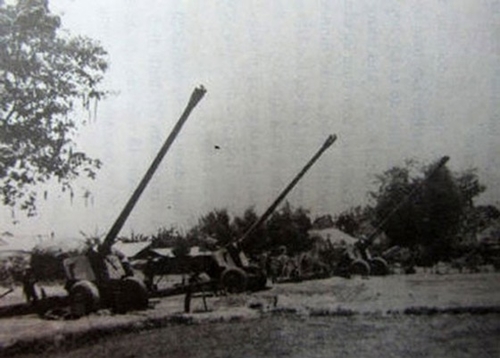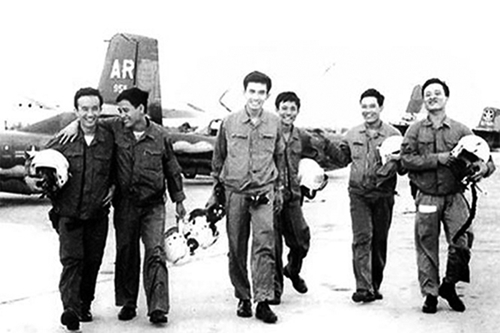From the East, Division 7 under Army Corps 4 quickly reached Suoi Dia, then moved along Road 1 to Long Lac and Ho Nai. There, the division was counter-attacked by the enemy. The battles from Ho Nai to Tam Hiep were extremely intense. The 3rd Armored Brigade, 4th Airborne Brigade, and local forces of the enemy stubbornly fought back from a strongly-fortified defensive system, causing a lot of difficulties for the liberation troops.
From the Southeast, Infantry Division 325 of Army Corps 2 concentrated its forces and firepower on attacking Nhon Trach. After hours of violent combat, the liberation troops completely captured Nhon Trach. Infantry Division 325 quickly assigned part of Artillery Brigade 164 to capture favorable terrains to shell Tan Son Nhat Airport.
    |
 |
|
At artillery combat position of the of the Liberation Army |
Troops from the East and Southeast offensive directions opened fire to capture the enemy’s checkpoints at bridges. At Dong Nai Highway bridge, despite the multi-layer defensive system of the enemy both on the river and at both ends of the bridge, Commando Unit 116 opened fire in a surprising offensive and took hold of the bridge, helping revolutionary troops advance into central Saigon.
From the Northwest, Infantry Division 316 of Army Corps 3 pushed back two counter-attacks from enemy infantry and tank units in Trang Bang. The siege tightened, asserting increasing pressure on the enemy. Facing the powerful offensive of the liberation force, on April 28, a battalion of the 50th Regiment of the enemy surrendered.
    |
 |
|
Quyet Thang squadron from the Air Force of the Liberation Army before bombing Tan Son Nhat airport |
From the North, the Command of Division 320B under Army Corps 1 decided to concentrate part of its force (regiments 27 and 48) and a number of firepower detachments on breaking up the stronghold in Ong Linh airport, clearing the way for revolutionary troops to reach Road 16 and carry out offensive operations as planned.
The enemy’s outer defense line in northern Saigon basically collapsed. Road 13 and Road 14 were blocked by Division 312. The enemy’s 5th Division was completely separated. Its regiments were unable to support Saigon or regiments of the division itself. On April 28, leaflets were fired into Lai Khe base and high-powered loudspeakers were used to call on troops of the 5th Division to surrender.
From the West and Southwest, Corps 232 and Division 8 of Military Region 8 attacked and took hold of An Ninh and Loc Giang. Division 3 crossed the Vam Co Dong River, attacked Duc Hoa and Duc Hue military sub-regions, and destroyed Tra Cu base. Division 9 then crossed the Vam Co Dong River to advance to Saigon while Division 5 and Division 3 attacked and destroyed the 22nd Division of the enemy in Thu Thua, Tan An, Duc Hue, and Duc Hoa. They then maneuvered to Saigon with Division 9.
The tightening siege around Saigon by the regular army corps of the Liberation Army made the Saigon Government melt down quickly. Chief of the Joint General Staff of the Saigon military Cao Van Vien fled overseas after filing the order “fight to the last breath to keep the remaining land.” In a panic, many generals of the Saigon military began to seek ways to evacuate their families.
On the afternoon of April 28, Tran Van Huong handed over power to Duong Van Minh. At the presidential inauguration ceremony, Duong Van Minh, as the Commander-in-Chief of the military of the Republic of Vietnam, called on the troops to “continue protecting the remaining land.”
Less than 10 minutes after Duong Van Minh finished his inauguration speech, a squadron from the Air Force of the Liberation Army led by Captain Nguyen Thanh Trung bombed Tan Son Nhat airport. The bombing destroyed 24 aircrafts, killed and injured more than 100 enemy troops, and destroyed the command and control system at the airport.
The surprising air raid caused further chaos among enemy troops.
Translated by Huu Duong